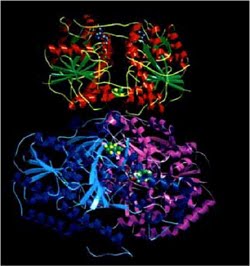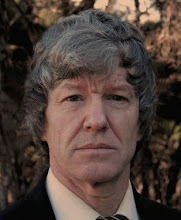Monday, June 13, 2011
CAN DNA DO QUANTUM COMPUTING?
This article on ScienceDaily suggests that it can. That would help explain why biodevelopment is so smart. It has underlying computer power far in advance of anything computer scientists have yet to develop. It would be ironic if after struggling for years to develop a quantum computer we found out that our own DNA has been doing it for aeons.
Tuesday, June 7, 2011
DNA CAN DETECT QUANTUM STATES
German research has established that DNA can distinguish between quantum states known as spin in electrons.
Quantum phenomena, it is generally agreed, take place in extremely tiny systems. Single atoms, for instance, or very small molecules. To investigate them, scientists must usually cool their material down to temperatures approaching absolute zero. Once such a system exceeds a certain size or temperature, its quantum properties collapse. Biological molecules are quite large, and work at temperatures that are much warmer than the temperatures at which most quantum physics experiments are conducted. One would expect that the quantum phenomenon of spin, which exists in two opposing states, would be scrambled in these molecules, and thus irrelevant to their function.
But biological molecules have another property: they are chiral. They exist in either left- or 'right-handed forms that cannot be superimposed on one another. Double-stranded DNA molecules are doubly chiral, both in the arrangement of the individual strands and in the direction of the helices' twist.
To see if DNA could detect spin the researchers fabricated self-assembling, single layers of DNA attached to a gold substrate. They then exposed the DNA to mixed groups of electrons with both directions of spin. The results surpassed expectations: The biological molecules reacted strongly with the electrons carrying one of those spins, and hardly at all with the others. The longer the molecule, the more efficient it was at choosing electrons with the desired spin, while single strands and damaged bits of DNA did not exhibit this property. These findings imply that the ability to pick and choose electrons with a particular spin stems from the chiral nature of the DNA molecule, which somehow sets the preference for the spin of electrons moving through it.
Full story at ScienceDaily.
Quantum phenomena, it is generally agreed, take place in extremely tiny systems. Single atoms, for instance, or very small molecules. To investigate them, scientists must usually cool their material down to temperatures approaching absolute zero. Once such a system exceeds a certain size or temperature, its quantum properties collapse. Biological molecules are quite large, and work at temperatures that are much warmer than the temperatures at which most quantum physics experiments are conducted. One would expect that the quantum phenomenon of spin, which exists in two opposing states, would be scrambled in these molecules, and thus irrelevant to their function.
But biological molecules have another property: they are chiral. They exist in either left- or 'right-handed forms that cannot be superimposed on one another. Double-stranded DNA molecules are doubly chiral, both in the arrangement of the individual strands and in the direction of the helices' twist.
To see if DNA could detect spin the researchers fabricated self-assembling, single layers of DNA attached to a gold substrate. They then exposed the DNA to mixed groups of electrons with both directions of spin. The results surpassed expectations: The biological molecules reacted strongly with the electrons carrying one of those spins, and hardly at all with the others. The longer the molecule, the more efficient it was at choosing electrons with the desired spin, while single strands and damaged bits of DNA did not exhibit this property. These findings imply that the ability to pick and choose electrons with a particular spin stems from the chiral nature of the DNA molecule, which somehow sets the preference for the spin of electrons moving through it.
Full story at ScienceDaily.
Subscribe to:
Posts (Atom)



